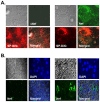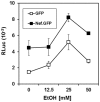HIV-1 Nef is transferred from expressing T cells to hepatocytic cells through conduits and enhances HCV replication
- PMID: 24911518
- PMCID: PMC4050050
- DOI: 10.1371/journal.pone.0099545
HIV-1 Nef is transferred from expressing T cells to hepatocytic cells through conduits and enhances HCV replication
Abstract
HIV-1 infection enhances HCV replication and as a consequence accelerates HCV-mediated hepatocellular carcinoma (HCC). However, the precise molecular mechanism by which this takes place is currently unknown. Our data showed that infectious HIV-1 failed to replicate in human hepatocytic cell lines. No discernible virus replication was observed, even when the cell lines transfected with HIV-1 proviral DNA were co-cultured with Jurkat T cells, indicating that the problem of liver deterioration in the co-infected patient is not due to the replication of HIV-1 in the hepatocytes of the HCV infected host. Instead, HIV-1 Nef protein was transferred from nef-expressing T cells to hepatocytic cells through conduits, wherein up to 16% (average 10%) of the cells harbored the transferred Nef, when the hepatocytic cells were co-cultured with nef-expressing Jurkat cells for 24 h. Further, Nef altered the size and numbers of lipid droplets (LD), and consistently up-regulated HCV replication by 1.5∼2.5 fold in the target subgenomic replicon cells, which is remarkable in relation to the initially indolent viral replication. Nef also dramatically augmented reactive oxygen species (ROS) production and enhanced ethanol-mediated up-regulation of HCV replication so as to accelerate HCC. Taken together, these data indicate that HIV-1 Nef is a critical element in accelerating progression of liver pathogenesis via enhancing HCV replication and coordinating modulation of key intra- and extra-cellular molecules for liver decay.
Conflict of interest statement
Figures








Similar articles
-
Signature molecules expressed differentially in a liver disease stage-specific manner by HIV-1 and HCV co-infection.PLoS One. 2018 Aug 23;13(8):e0202524. doi: 10.1371/journal.pone.0202524. eCollection 2018. PLoS One. 2018. PMID: 30138348 Free PMC article.
-
Nef-mediated enhancement of cellular activation and human immunodeficiency virus type 1 replication in primary T cells is dependent on association with p21-activated kinase 2.Retrovirology. 2011 Aug 5;8:64. doi: 10.1186/1742-4690-8-64. Retrovirology. 2011. PMID: 21819585 Free PMC article.
-
HIV-1 Nef interacts with HCV Core, recruits TRAF2, TRAF5 and TRAF6, and stimulates HIV-1 replication in macrophages.J Innate Immun. 2013;5(6):639-56. doi: 10.1159/000350517. Epub 2013 Jun 13. J Innate Immun. 2013. PMID: 23774506 Free PMC article.
-
Nef does not inhibit F-actin remodelling and HIV-1 cell-cell transmission at the T lymphocyte virological synapse.Eur J Cell Biol. 2011 Nov;90(11):913-21. doi: 10.1016/j.ejcb.2010.09.010. Epub 2010 Nov 1. Eur J Cell Biol. 2011. PMID: 21044805
-
Consequences of HLA-B*13-Associated Escape Mutations on HIV-1 Replication and Nef Function.J Virol. 2015 Nov;89(22):11557-71. doi: 10.1128/JVI.01955-15. Epub 2015 Sep 9. J Virol. 2015. PMID: 26355081 Free PMC article.
Cited by
-
Nef-induced CCL2 Expression Contributes to HIV/SIV Brain Invasion and Neuronal Dysfunction.Front Immunol. 2019 Oct 15;10:2447. doi: 10.3389/fimmu.2019.02447. eCollection 2019. Front Immunol. 2019. PMID: 31681324 Free PMC article. Review.
-
A Tale of Two Viruses: Immunological Insights Into HCV/HIV Coinfection.Front Immunol. 2021 Aug 12;12:726419. doi: 10.3389/fimmu.2021.726419. eCollection 2021. Front Immunol. 2021. PMID: 34456931 Free PMC article. Review.
-
The role of MDM2-p53 axis dysfunction in the hepatocellular carcinoma transformation.Cell Death Discov. 2020 Jun 19;6:53. doi: 10.1038/s41420-020-0287-y. eCollection 2020. Cell Death Discov. 2020. PMID: 32595984 Free PMC article. Review.
-
Oncogenic Effects of HIV-1 Proteins, Mechanisms Behind.Cancers (Basel). 2021 Jan 15;13(2):305. doi: 10.3390/cancers13020305. Cancers (Basel). 2021. PMID: 33467638 Free PMC article. Review.
-
Virological Mechanisms in the Coinfection between HIV and HCV.Mediators Inflamm. 2015;2015:320532. doi: 10.1155/2015/320532. Epub 2015 Oct 1. Mediators Inflamm. 2015. PMID: 26494946 Free PMC article. Review.
References
-
- Alter MJ (2006) Epidemiology of viral hepatitis and HIV co-infection. J Hepatol 44: S6–9. - PubMed
-
- Salmon-Ceron D, Lewden C, Morlat P, Bevilacqua S, Jougla E, et al. (2005) Liver disease as a major cause of death among HIV infected patients: role of hepatitis C and B viruses and alcohol. J Hepatol 42: 799–805. - PubMed
-
- Thein HH, Yi Q, Dore GJ, Krahn MD (2008) Natural history of hepatitis C virus infection in HIV-infected individuals and the impact of HIV in the era of highly active antiretroviral therapy: a meta-analysis. AIDS 22: 1979–1991. - PubMed
Publication types
MeSH terms
Substances
Grants and funding
LinkOut - more resources
Full Text Sources
Other Literature Sources
Research Materials

